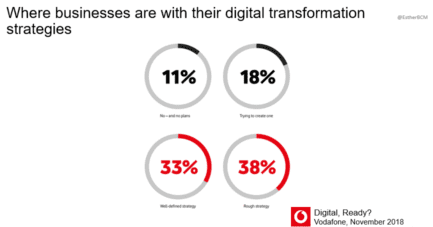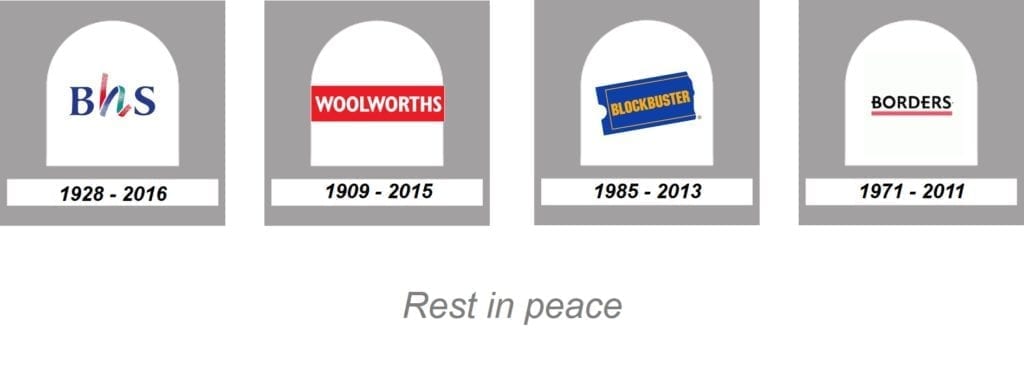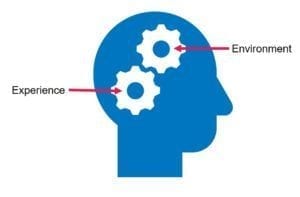Digital Transformation is no longer the new kid on the block. But the need to deliver a transformation efficiently and effectively has never been more important. So why do Digital Transformations fail?
That’s why I was pleased to see the immense turnout for DIGIT.FYI’s 4th Annual Digital Transformation Conference last week. The great and good from across industries gathered at Dynamic Earth to get insights from industry experts. I was lucky enough to run two breakout sessions sharing my experience of why digital transformations fail. And how you can stop them by setting clear goals, using critical thinking and developing a user centred culture.
The cost of digital transformations failing
Digital technology has changed the way we do business. If you don’t provide the experiences that your users want, how and when they want it, they will go elsewhere.
Yet, in a World where people own more connected devices than toothbrushes, it’s amazing how few organisations have not fully defined or implemented a digital transformation strategy.
In fact, Vodafone’s Digital, Ready? survey of over 2,000 business leaders in the UK, as recently as November 2018, discovered only 33% said they had a well-defined transformation strategy:

Even though 79% said that Digital Transformation was a strategic priority that they were keen to exploit, and 69% recognised that if their digital transformations fail, they will cease to exist as an organisation.
And the cost of failure is huge. Over the last decade we have seen some of the World’s leading organisations sink millions into failed transformations. The BBC had to write off £98.3 million of unusable technology assets after their failed Digital Media Initiative which was supposed to revolutionise their operations, data management and content delivery.
Or the Co-operative bank who ambitiously spent £300 million trying to change their core infrastructure, building it from the ground up. But they ended up abandoning the programme after 7 years as it was too complex. This was a factor that led to the bank having a £1.5 billion capital shortfall. Or the scarier examples where well-known brands are completely disrupted, left behind and just cease to exist.

The 4 key mistakes of digital transformation
So, what goes wrong? Why do experienced leaders of industry manage to fail at implementing successful digital transformation strategies?
Well in my experience it comes down to 4 key mistakes:
1. Too many assumptions

All too often people start making decisions based on assumptions, not fact. This is usually because they don’t really understand the problem they’re trying to solve. Sure, they may know they need to be more efficient, become digital, stay with the trends, keep up with compliance, etc. But they tend to forget to discover what their stakeholders want and make one key assumption: if they build it, we will come.
This simple but dangerous mistake is how digital transformations fail. Organisations waste time, money and resources on trying to deliver something that no one wanted in the first place. Instead they should first answer the questions:
- ‘What are we trying to achieve and why?’
- ‘What do our customers want from us?’
- ‘How might we be able to deliver it?’
And turn their assumptions into hypotheses that can be tested.
2. Too fast

Whether it’s due to a rush to get to market, get ahead of a trend, or a desperate attempt to catch up with their competitors, going too fast often means corners get cut.
When trying to implement something quickly it is easy to put speed ahead of value. Which results in developing a sub-par product or a hastily copied proposition from a competitor. The danger of going too fast goes beyond just not validating assumptions. It also encourages project teams to skimp on the strategic planning, forget about the design stage and get straight into Agile, or other favourite flavour of development. But poor planning and design means that they do not have a shared vision for transformation, nor a clear set of goals and metrics to know when they have achieved their objectives. All of which are the foundation of good stakeholder communication. Hence their digital transformation fails.
Worse still, when you are in the thick of a fast transformation and the pressure is on, other corners get cut, like testing and compliance. This makes it more likely to launch a product that is not fit for purpose, let alone fit for market.
3. Too slow

At the opposite end of the continuum from going too fast is going too slow. As I’ve said before people who don’t provide what users want, and how, will be disrupted. Other new entrants will provide better products and services, potentially for substantially lower costs, and no brand wants to be the next Blockbuster video. But this is not the only danger of going too slow.
Because organisations that drag out digital transformation, lose the momentum of their teams. They lose the vision, trust and the belief in what they are doing. And ultimately, they lose their talented resources. That is why a good digital strategy is implemented at the right pace, not too fast that corners are cut, yet not too slow that you miss the opportunity or lose the buy-in of your stakeholders.
4. Too much

The final key mistake that makes digital transformations fail is trying to do too much at once. Sure, the word is transformation and should be a full-scale step change. But there is no need to do everything at once. Think about the issues that the Co-operative bank had from biting off more than they could chew. Trying to deliver too much, too fast, can result in stretching your resources too thinly and not delivering anything of value, if at all.
A much better approach is to go back to the framing of the problem, the needs of the users and prioritise them based on effort and impact. Chunking up transformations into smaller projects that can be delivered efficiently and effectively. This mitigates the risk of burnout of your team and lack of resource (and/or budget). Teams can effectively deliver smaller projects and use the return on investment of these smaller changes to fund future projects.
Bias in decision making

So why do we see leaders of industry and World class brands continuously make these mistakes? Well its due to our inherent bias in decision making. We are all products of our experience and environment. And these factors dictate our expectations of what we think people think, feel and do. Therefore, we have certain biases when we make decisions.
This bias makes us think faster than we should, and believe we have the right answers, when actually we don’t have a clue. And whilst we may not wish to admit we have bias in us, if we don’t acknowledge it and challenge it, then we run the risk of making poor decisions.
What is bias?
The dictionary has the definition of bias as:
“The action of supporting or opposing a particular person or thing in an unfair way, because of allowing personal opinions to influence your judgement.”
There are hundreds of different types of cognitive bias that affect the way you think and act. However, there are three key biases I believe affect the decisions made in Digital Transformation Projects:
Confirmation bias
Confirmation bias is where you only search, interpret and favour information and evidence that confirms your own beliefs and expectations. People often only see what they want to see and hear, rather than looking at the facts before them. All too often we choose to ignore the facts that don’t validate our own beliefs, and only focus on those that do. If we make decisions based on our own confirmation bias then we aren’t truly thinking about what users want and need, but what we want and need, and then assuming that users are all like us. Instead it is important to examine the facts equally, test them vigorously and challenge your own way of thinking.
Self-serving bias
Self-serving bias is where you tend to claim more responsibility for your successes and blame your failures on external factors, such as the other people, economy, Brexit. The danger here is that if we only see ourselves responsible for success and not failure and use the blame culture of ‘It’s not my fault’ we tend to make decisions that will protect this viewpoint (confirmation bias). So, we fail to understand the problem we face, why things resulted in the way they did and how might we do things differently in the future.
Status quo bias
The final type of cognitive bias to watch for is status quo bias which is the tendency to like things to stay the same. How many times when you have been talking about a change in the way you do things at work, no matter how small, someone has responded ‘but that’s the way we’ve always done it’? That’s because we like our habits and processes, as they help us keep things consistent and we know what to expect. We like our comfort zones. But if we keep doing things the same way, we’ll get the same results. In order to not stagnate, we must try to disrupt the status quo and embrace change, as uncomfortable as that might be at times. Because if we don’t disrupt ourselves, history has taught us that someone else will.
How to stop bias affecting your decision making
1. Acknowledge it
The first step is to acknowledge it. It’s hard to acknowledge that you are biased and that you are a product of your experience and environment. But it is important that you acknowledge and accept it.
2. Frame it
Think about what are you biased about? Is there one idea that you particularly want to develop so all your research and evidence is based around that? Are you convinced that the failure of your project was Theresa May’s dilly dallying over Brexit, or did people just not want your proposition? Or are you missing an opportunity because you are comfortable with where you are, for now? Once you frame where your bias lies you can understand what it is.
3. Challenge it
Finally, challenge it. And challenging it can be hard, but it is imperative to success. Surround yourself with competent people, who are good at what they do but not necessarily like you. Get the thoughts, opinions, and ideas from a group of diverse people and discover what other people think and why. Listen to them and let them help you see things in a different way.
Building a framework for successful decision making
In order to truly combat bias, I recommend you build your own framework for decision making based on my three pillars of success:
-
Set clear goals from the outset
-
Use critical thinking
-
Develop a user centred culture.
Set clear goals

If you don’t have clear goals so that all your stakeholders understand what needs to be done and why, you are setting yourself up to fail. Generally, there are three key goals of any digital transformation:
- Increasing operational efficiency
- Increasing customer engagement through new, unique experiences
- Meeting regulation and compliance.
Achieving one of these three goals should result in a return on your investment but a successful digital transformation relies on a successful combination of all three.
Whatever your specific goals make sure that they are clear: What are you trying to achieve and why? And remember to identify what are the metrics of success that will tell you when you get there?
Use critical thinking
Critical thinking is disciplined thinking that is clear, rational, open-minded and informed by evidence. It has been around for thousands of years and is the basis of the scientific method. It is the best way to combat your confirmation bias.
By developing hypotheses and then testing them using critical thinking frameworks you will be able to make decisions objectively by removing your subjective likes and dislikes. Therefore, you gain strategic clarity and make better informed decisions to meet your clear goals, faster.
Develop a user centred culture

Surround yourself with curious, competent but different people. And make sure that you put your people at the heart of everything you do: your customers, your employees and your shareholders.
By building a culture of empathy and understanding of what your stakeholders want and need, and then harmonising them with your goals, you will build momentum and buy-in, across all levels of the organisation, AND deliver what matters most to your customers and your organisation.
Even better, take it one step further and start to co-create with your stakeholders and take an open approach to innovation. That way you’ll know what works, and what doesn’t, faster by rapidly generating and testing ideas with real people.
This is the most important pillar of success. As it is only by taking a truly user centred approach to transformation that you can focus your organisation on what matters most, remove your inherent bias and develop better solutions that people actually want.
Thank you to everyone who came to #DTScot 2019
I’d like to say a big thank you to everyone who came along to hear my take on why Digital Transformations fail and how to stop them. And as always, a massive thank you to the team at Digit.FYI for organising another fantastic event.
You can find coverage of the day on Twitter or the slides from the day and my talk ‘Why Digital Transformations Fail’ here:
Look forward to seeing you all next year at #DTScot 2020!






